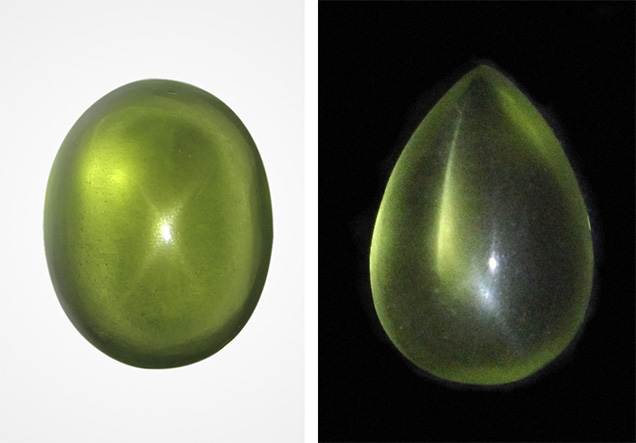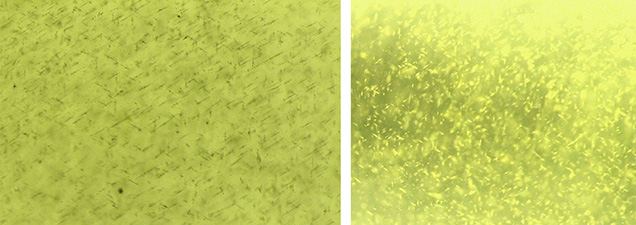Burmese Star Peridot

Asterism in peridot is a rare treat that has been reported on occasionally (S. Borg, “An unusual star peridot,” Journal of Gemmology, Vol. 17, No. 1, 1980, pp. 1–4; Summer 2009 Lab Notes, pp. 138–139). In January 2020, Tom Trozzo submitted to Stone Group Laboratories a 20.13 ct oval cabochon peridot (figure 1, left) that exhibited a soft yet prominent four-rayed star. Comparisons were made with an in-house lab sample that also exhibited reflection effects from tiny acicular inclusions. For purposes of this study, this comparison stone was recut to a 7.67 ct pear-shaped cabochon (figure 1, right) to enhance any potential asterism. However, the result appeared to be more of a cat’s-eye effect, presumably due to the prominent keel from the original faceted pear shape. It is presumed that, based on the arrangement and concentration of inclusions, a more prominent asterism will be revealed upon further cutting. Apparent clarity was good on both stones, but with a slightly diffused effect; no large eye-visible inclusions were present. While the asterism was more pronounced on the oval, the acicular inclusions were more plentiful and of higher relief in the pear-shaped stone. Both stones had a yellowish green color, with the oval exhibiting a very slight grayish modifier.

Microscopic observation of the larger oval peridot revealed evenly distributed concentrations of extremely fine, short, brownish, acicular inclusions oriented in two directions (figure 2, left). In the pear shape, the needles were evenly dispersed throughout and oriented in three directions. The needles were also short and whitish to colorless (figure 2, right). Reflection effects in some materials may be difficult to define. There may be reflection effects from nonacicular inclusions, creating schiller as well as asterism. This was the case with the oval peridot, although asterism was clearly the dominant phenomenon.
The spot RI reading of approximately 1.65 and hydrostatic SG of 3.33 were consistent with peridot. The identification of both peridots was confirmed by Gemmo-Raman532-SG. Their provenance was reportedly Myanmar (Burma), and all tests were consistent with a Burmese origin. Interestingly, all known star peridots to date have been of Burmese origin. Although Pakistani peridot may often feature acicular inclusions of ludwigite, these are presumably protogenetic and not oriented consistently to the crystal structure of the host peridot.



